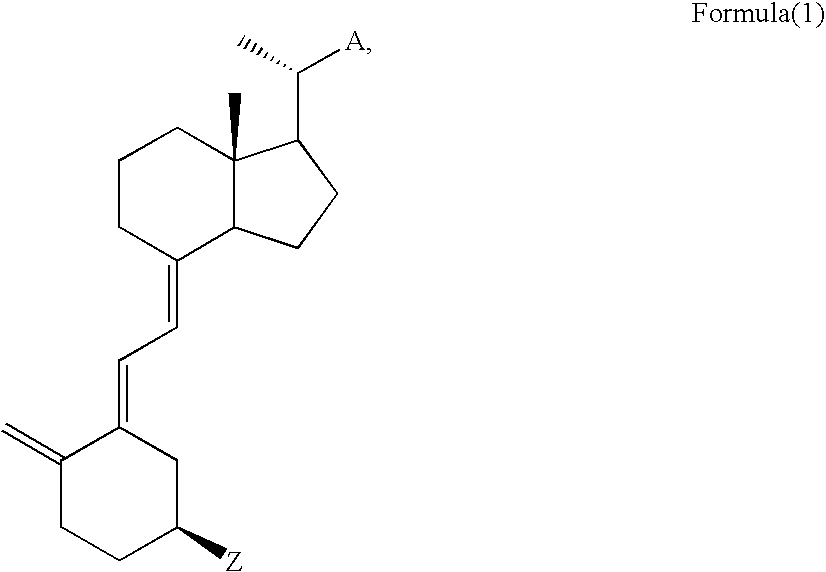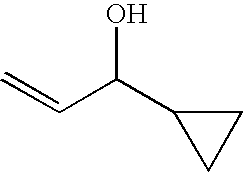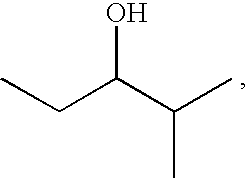Method for preparing analogue of vitamin D
a technology of c1hydroxylc24hydroxylvitamin d and analogue, which is applied in the field of preparation of analogue of c1hydroxylc24hydroxylvitamin d, can solve the problems of not being suitable for mass production, not having special oxidants, and not having the ability to meet the requirements of a single molecule,
- Summary
- Abstract
- Description
- Claims
- Application Information
AI Technical Summary
Benefits of technology
Problems solved by technology
Method used
Image
Examples
example 1
Preparation of Compound 2 (Z=t-BuMe2SiO)
[0034] Vitamin D2 (2 kg, 5.04 mol), tert-butyldimethylsilyl chloride (1.16 kg, 7.70 mol), and imidazole (1.03 kg, 15.15 mol) are dissolved in dichloromethane (20 L). The mixture is stirred at room temperature for 2 hours. After the reaction is complete, the reaction mixture is checked by TLC (with an eluent of 10% ethyl acetate in hexane). The reaction mixture is washed with water (6 L), sodium chloride aqueous solution (6 L), and water (6 L) in sequence. The organic layer is concentrated under reduced pressure, and compound 2 (2.5 kg) is obtained. The product obtained can be used in the subsequent reaction without further purification.
[0035] Compound 2 (Z=t-BuMe2SiO): 1H NMR (200 MHz, CDCl3) δ 0.07 (s, 6H), 0.56 (s, 3H), 3.77-3.86 (m, 1H), 4.14 (s, 1H), 4.78 (s, 1H), 5.09-5.28 (m, 2H), 6.02 (d, 1H, J=11.2 Hz), 6.17 (d, 1H, J=11.2 Hz).
example 2
Preparation of Compound 3 (Z=t-BuMe2SiO)
[0036] Compound 2 (2.50 kg, 4.89 mol) prepared in example 1 is dissolved in dichloromethane (20 L) to form a solution. The solution is then added to a saturated sulfur dioxide (SO2) aqueous solution (10 L), and then stirred at room temperature for 2 hours. After the reaction is complete, the reaction solution is checked by TLC (with an eluent of 10% ethyl acetate in hexane). The reaction solution is heated to remove SO2. The residue after evaporation is dissolved in ethyl acetate (6.3 Kg). The resulted ethyl acetate solution is washed with water, and concentrated to give compound 3 (2.72 kg). The product obtained can be used for the subsequent reaction without further purification.
example 3
Preparation of Compound 4 (Z=t-BuMe2SiO)
[0037] Compound 3 (2.72 kg, 4.73 mol) prepared in example 2 is dissolved in a mixture of dichloromethane (25 L) and methanol (2.5 L) to form a solution. The solution is cooled to −60° C., and ozone is introduced to it. The reaction solution is monitored and checked by TLC (with an eluent of 30% ethyl acetate in hexane). When the starting material is depleted, the reaction is quenched.
[0038] Then nitrogen is introduced to the solution, and dimethyl sulfide (1.6 kg, 25.81 mol) is added to the solution subsequently. The resulted solution is heated to room temperature slowly to quench the extra ozone. Dichloromethane (13.2 L) is added to the quenched solution. The resulted mixture is washed with water, and concentrated to give compound 4 (2.20 kg).
PUM
| Property | Measurement | Unit |
|---|---|---|
| temperature | aaaaa | aaaaa |
| temperature | aaaaa | aaaaa |
| temperature | aaaaa | aaaaa |
Abstract
Description
Claims
Application Information
 Login to View More
Login to View More - R&D
- Intellectual Property
- Life Sciences
- Materials
- Tech Scout
- Unparalleled Data Quality
- Higher Quality Content
- 60% Fewer Hallucinations
Browse by: Latest US Patents, China's latest patents, Technical Efficacy Thesaurus, Application Domain, Technology Topic, Popular Technical Reports.
© 2025 PatSnap. All rights reserved.Legal|Privacy policy|Modern Slavery Act Transparency Statement|Sitemap|About US| Contact US: help@patsnap.com



